Open Journal of Earthquake Research
Vol.3 No.2(2014), Article ID:46459,11 pages
DOI:10.4236/ojer.2014.32007
First Determination of Source Parameters of Moderate Earthquakes (4.1 ≤ M ≤ 5.1) in Morocco from Spectral Analysis
Ihsane Bensaid1,2, Lahcen Bahi2, Fida Medina3
1Université Mohammed V-Agdal, Institut Scientifique, Laboratoire de Physique du Globe, Equipe Géophysique de Subsurface, Rabat, Morocco
2Université Mohammed V-Agdal, Ecole Mohammedia d’Ingénieurs, Rabat, Morocco
3Université Mohammed V-Agdal, Institut Scientifique, Laboratoire de Géologie et Télédétection (URAC 46), Equipe Télédétection, Risques et Ressources Naturelles, Rabat, Morocco
Email: bensaid@israbat.ac.ma, bahi@emi.ac.ma, medina@israbat.ac.ma
Copyright © 2014 by authors and Scientific Research Publishing Inc.
This work is licensed under the Creative Commons Attribution International License (CC BY).
http://creativecommons.org/licenses/by/4.0/



Received 18 February 2014; revised 20 March 2014; accepted 27 April 2014
ABSTRACT
Recent installation of an array of broad band seismological stations in Morocco allowed us to study the records of five recent (2005-2008) moderate earthquakes (4.1 ≤ M ≤ 5.1) in order to determine their source parameters (seismic moment, fault slip, rupture area and stress drop) from P-wave spectra. We also studied the older Rissani events of 1992 using teleseismic data. Values of Mo, r, Δu and Δσ are, respectively, 1.1 × 1013 - 6 × 1016 Nm; 0.50 - 3.9 km; 0.8 - 5.8 cm and 0.3 - 1.49 MPa. The results are in accordance with the seismotectonic and geodynamic setting of Morocco as, for instance, the amount of slip along the faults with respect to the relative displacement of Nubia to Iberia (~4 mm∙yr−1) determined from GPS data, taking into account the period of stress accumulation. However, some events show very variable corner frequency and low-frequency amplitude values which lead to considerably higher stress drop and fault slip values, especially at the nearest stations, which may reflect some site effects or uncertainties on depth and take-off angles.
Keywords:Morocco, Seismicity, Fault-Plane Solutions, P-Wave Spectra, Source Parameters, Seismotectonics

1. Introduction
Morocco is located at the westernmost extremity of the complex Ibero-Maghrebian area, where the Azores-Gibraltar fault zone enters the continental lithosphere of the Betics-Rif-Alboran block. Along this boundary, the present-day convergent plate motion of the Nubian plate with respect to Iberia occurs along a NW-SE trend, as shown by plate kinematic, focal mechanism and GPS studies [1] -[11] . The amount of convergence is about 4 mm∙yr−1, most of which is accommodated by earthquakes (Figure 1). Within this setting, a remarkable discrepancy is the NE-SW escape of the Central Rif block determined by GPS observations [4] [8] [12] -[14] and faultplane solutions [10] in conformity with geological studies e.g. [14] [15] .
Earthquakes in Morocco have shallow foci [16] -[22] , but a few events have focal depths of 100 km beneath the Middle Atlas [20] [23] and in northwestern Morocco and adjacent Alboran area [2] [20] .
Although there is a large dataset on the fault-plane solutions of earthquakes in Morocco (see exhaustive compilation in [24] ), little information exists on the other source parameters. The published studies were conducted only on the largest shocks, in particular on the 1994 and 2004 Al Hoceima, and the 1992 Rissani earthquakes, on the base of waveform analysis [4] [21] [25] , but no studies based on spectral analysis were carried out, with the exception of that published by Bensaid et al. [26] on the Rissani earthquakes.
Since 2006, numerous broad band stations (BBS) were installed around the western Mediterranean in the context of international cooperation and projects ([27] [28] , Figure 2); these BBS provided high-quality digital data which allowed us to obtain a certain number of spectra, and therefore, to attempt determining the source parameters which have been done for other Mediterranean seismogenic areas from P-waves e.g. [29] [30] and Swaves e.g. [31] .
In this paper, we expose the results of the study of the source parameters of 5 moderate shocks that occurred in Morocco during the period 2005-2008 together with two stronger shocks in 1992, corresponding to the Rissani earthquakes. Our leading objective was to attempt to determine the source parameters from these shocks from the P-wave spectra, such as the seismic moment, the fault dimension and displacement, the “stress drop”, and to compare the results to available data on the kinematics and seismicity of the Africa-Iberia plate boundary.
2. Database and Methodology
2.1. Data and Processing
We selected 5 events with magnitude M ≥ 4 that occurred during the period 2005-2008 [10] , and the Rissani events, two older shocks with magnitudes M ~ 5.2 which affected the Anti-Atlas area in 1992 [26] (Figure 2 and Table 1).
As exposed in a previous paper [10] , the hypocentral relocations were determined using the revised version of the HYPO71 computer program [32] , and a standard crustal model for Morocco with Vp/Vs = 1.74 [18] .
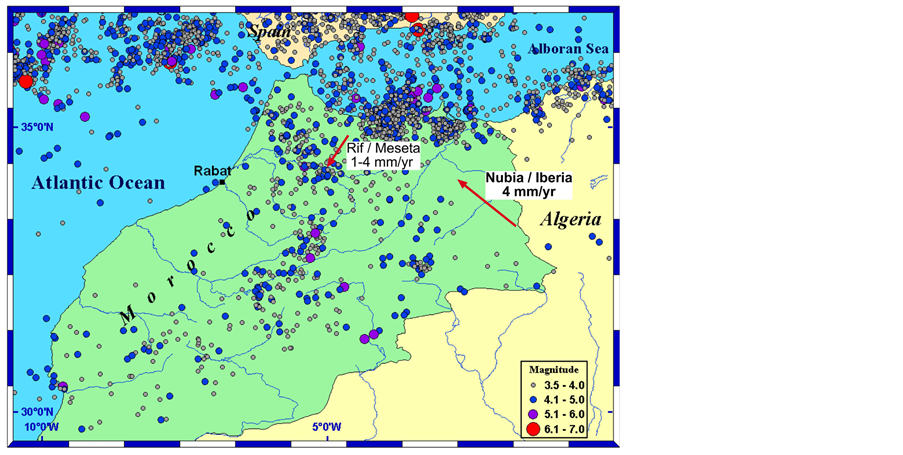
Figure 1. Seismicity of northern Morocco and adjacent area for the period 1990-2010, magnitudes > 3.5 (after [10] ).

Figure 2. Location of the earthquakes (stars) and Moroccan and southern Spanish stations (dots) used in the present study. See Table 1 for earthquake parameters.
Table 1. List of studied earthquakes.
Data in Standard for Exchange of Earthquake Data (SEED) format (FDSN) were retrieved from files of digital stations located in Morocco (Institut Scientifique, ING-CNRST, Siberia and WM networks), Algeria (GEOFON) and Europe (IGN network and German stations) at various epicentral distances between 43 and 2454 km.
SEED data were read using Rdseed software, and then converted into SAC (Seismic Analysis Code) or ASCII formats. SAC software was used to accomplish all mathematical operations such as Fourier transform, spectral estimation, IIR and FIR filtering, decimation, interpolation correlation, seismic phase picking and graphical output.
2.2. Fault-Plane Solutions
Fault-plane solutions based on P-wave arrivals on the recordings of the selected events were already published in previous papers [10] [26] . Summarizing, first motions of P-waves were read on available paper records and digital files of permanent and temporary stations. Take-off angles for stations at regional distances (less than 1000 km) were obtained for a crustal model formed by two flat layers (15 km each) with constant velocities 6.1 km∙s−1 and 6.7 km∙s−1. The IASPEI model was used for stations at larger distances. Solutions were obtained using the algorithm of Brillinger et al. [33] .
2.3. P-Wave Spectra
The bulk seismograms were cut at the onset of the Pand S-waves. The mean and the linear tendency were removed in order to centre the signal at zero and to stabilize the numerical operations respectively. Since the signal corresponds to velocity, data were integrated to obtain displacements (Figure 3). Once picked, the seismogram was deconvoluted by the velocity response of the recording instrument. Spectra were obtained from the original digital records using software SAC (Figure 3). Finally, the low-frequency (plateau) part (Ωo) and the corner frequency fc were automatically obtained from the signal using software KIV, and subsequently the source parameters.
As spectra can be affected by attenuation, we used two to six stations at variable epicentral distances in order to obtain a mean value.
2.4. Source Parameters
The source dimensions and scalar seismic moment were determined by spectral analysis using the circular fault model [34] [35] , which is the most suitable for small/moderate earthquakes generated along short faults that generally do not crosscut the Earth’s surface and do not show a well-defined aftershock pattern [36] .
The radiation pattern (R) for each station was computed from the fault-plane solution, and the scalar seismic moment M0 was estimated using the amplitude spectra of P-waves [37] .
 (1)
(1)
 (a)
(a) (b)
(b)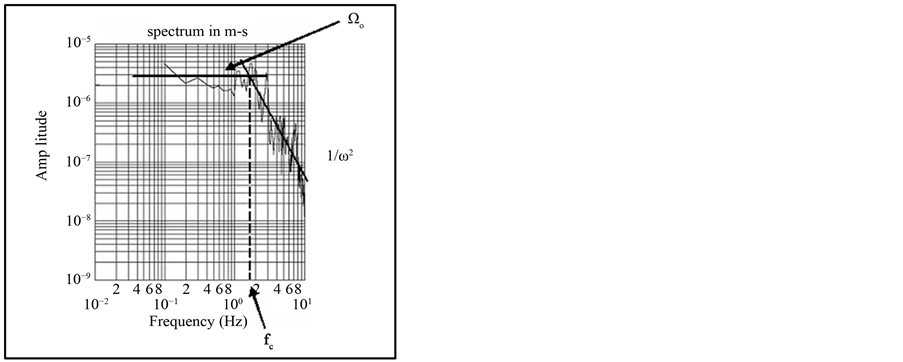 (c)
(c)
Figure 3. P-wave amplitude spectrum at station AVE for the event of 11 January 2008. (a) chosen window in the velocity record; (b) obtained displacement record after removing the instrument effect and integration; (c) amplitude spectrum showing plateau Ωo and corner frequency fc.
where ρ is the density, a is the fault radius, r is the distance from the focus
to the receiving station, g(∆) is the geometric attenuation, C(io)
is the effect of free surface on amplitude, Ωo is the spectral
amplitude at low frequency of P-wave displacement, ω is the angular frequency, Q
is the quality factor of P-wave (taken here as 300) and
 is the radiation factor corresponding to the source orientation given by
is the radiation factor corresponding to the source orientation given by , ih where
, ih where
 is the azimut of the station with respect to the fault,
is the azimut of the station with respect to the fault,
 is the dip of the fault-plane,
is the dip of the fault-plane,
 is the rake and ih is the take-off
angle.
is the rake and ih is the take-off
angle.
The dimension of the rupture (a) was evaluated from the corner frequency (fc) [37] :
 (2)
(2)
where α is the P-wave velocity.
The average displacement and stress drop were estimated from the scalar moment (M0) and dimensions [38] :
 (3)
(3)
The stress drop
 was determined using the equation [34] -[37] [39] :
was determined using the equation [34] -[37] [39] :
 (4)
(4)
Computations were performed at the Complutense University (Madrid) using softwares KIV and SAC (IRIS [40] ) to obtain the spectra of the P-wave, and MOS2 for determining M0 and source dimensions. The epicentral distance, azimut, and take-off angle were determined with the help of subroutine CASSOL. The radiation pattern R was obtained with MECSTA. The choice of the software was based on its availability at Madrid University and because it is the same than that used by Spanish researchers who have installed the WM network in Morocco.
3. Results
3.1. Focal Mechanisms
The fault-plane solutions and numerical parameters of the studied earthquakes [10] are respectively shown in Figure 4 and Figure 5 and listed in Table 2 respectively. In the central and eastern Rif (solutions 3 and 5), the solutions correspond to either almost-pure normal faulting or to strike-slip faulting with a normal component. The T-axes have an E-W trend. The solutions determined in the Middle Atlas chain and in the Meseta (solutions 4, 6 and 7) show almost-pure reverse faulting in two cases and strike-slip faulting with a normal component in another. In the three cases, the P-axis is oriented NW-SE. Finally, the solutions south of the High Atlas correspond to strike-slip faulting with a NW-SE oriented P-axis.
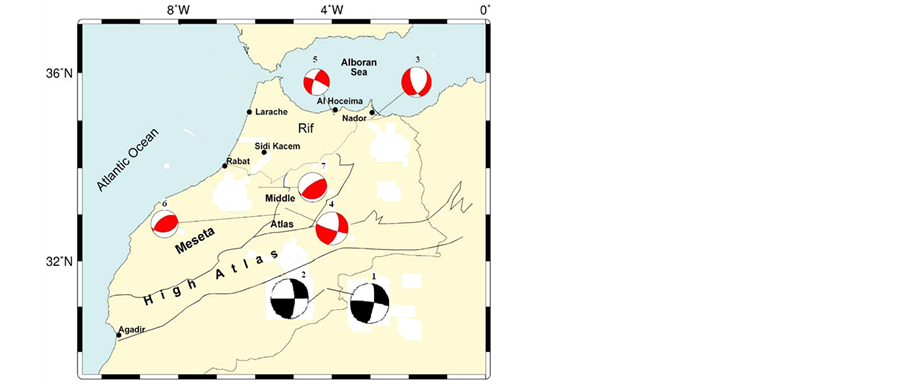
Figure 4. Location of the fault-plane solutions of the studied earthquakes, after [10] .
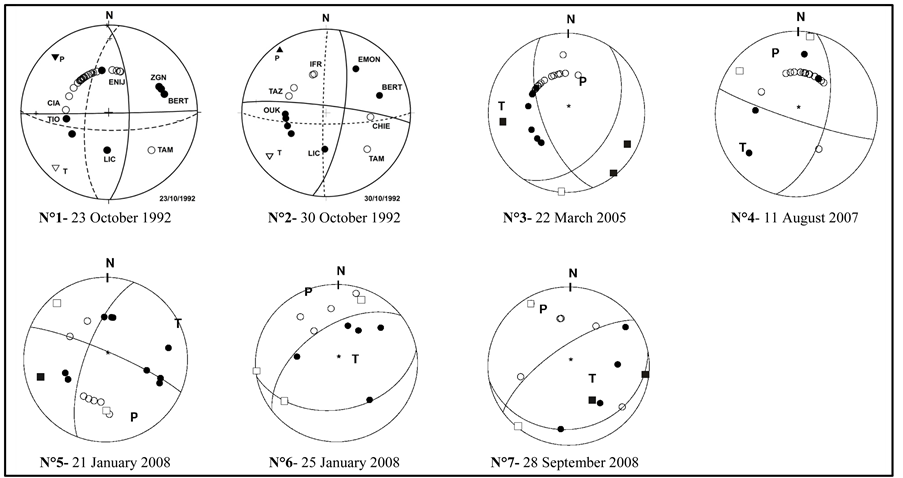
Figure 5. Detailed fault-plane solutions of the studied earthquakes (see Table 2 for the numerical parameters). Full circles = compression; empty circles = dilatation; squares = direct arrivals; P = pressure axis; T = tension axis; dashed traces in solutions 1 and 2 = solutions given by Harvard.
Table 2 . Fault-plane solutions of the studied earthquakes, after [10] .
3.2. Source Parameters from P-Wave Spectra
The characteristics of 29 spectra of the studied earthquakes such, as the low-frequency spectral amplitudes and the corner frequencies observed are indicated in Table 3. Selected examples for each event are shown in Figure 6. The source parameters (seismic moment, fault radius, moment magnitude, fault displacement and stress drop) calculated from these data are given in Table 4. For the largest events (#1 and 2), which correspond to the Rissani twin earthquakes of 23 and 30 October 1992, the fault radii are close to 4 km, the displacements are about 4 cm and the stress drops are 0.3 - 0.4 MPa.
The three smallest events show very similar parameters with fault radii close to 0.6 km, fault displacements of 1.26 to 2.41 cm and stress drops of 0.96 to 2.45 MPa. However, the parameters of the 22 March 2005 event ap
Table 3 . Spectral characteristics obtained from the stations for each studied earthquakes. R: radiation pattern; Ωo: flat lowfrequency amplitude; fc: corner frequency.
pear to be too high with respect to the other events, certainly because of the small number of available spectra. We also had to remove station M010 from the calculations of the 28 September 2008 source parameters, because it led to too high values.
In contrast, the M ~ 5 event that occurred in the Middle Atlas on 11 August 2007 shows very variable values of fault displacement (0.8 cm at ECEU to 87 cm at IFR) and stress drops (0.52 MPa at ECEU to 63 MPa at IFR), although the fault radii values are homogeneous (0.83 to 0.99 km). Therefore, we recalculated the source parameters shown in Table 4 without taking into account stations IFR and AVE, which provided too large values.
4. Discussion
4.1. Influence of the Quality of Data and Processing on the Obtained Results
Our study was initially intended to attempt determining the source parameters of the Moroccan moderate events for seismotectonic analysis. However, the results show that the variability of the parameters that lead to them may have a large influence on the obtained values.
First, it appears that the corner frequency values obtained from the spectra are not always homogeneous for the same event, especially at the nearest stations which display large discrepancies, as for instance in the case of stations IFR and AVE for the event recorded on 11 August 2008. This may be due to several parameters such as:
1) Site effects related to the geological composition of the basement, which may also have an influence on the stress drop.
2) Uncertainty on the hypocentral depth (Table 2), which may dramatically influence the estimation of the radiation pattern and subsequent calculations. Such discrepancies may currently be observed even within closely spaced stations, but within 30% of the mean value [41] .
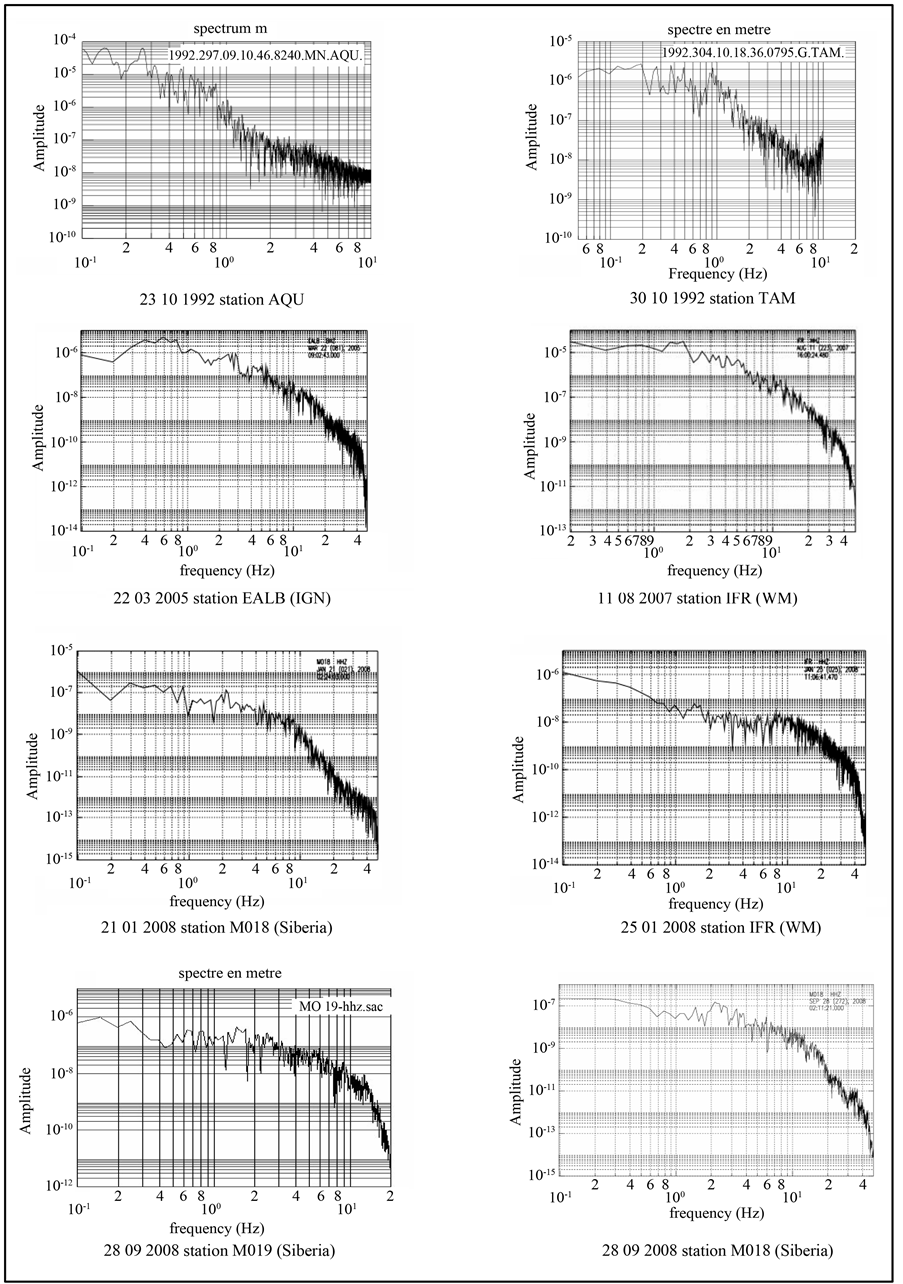
Figure 6. Selected examples of P-wave spectra for the studied earthquakes.
Table 4. Spectral characteristics obtained from the stations for each studied earthquakes. R: radiation pattern; Ωo: plateau amplitude; fc: corner frequency.
3) The use of the circular fault model of Brune [34] [35] , because we consider that a rectangular fault surface would be more realistic tectonically, but it was impossible to use it because of several parameters such as the small size of the earthquakes, the large depth of some of them and therefore the absence of an aftershock series which could have provided more information on the fault surface.
Therefore, we consider that a more systematic study, using a larger number of stations by event is needed in order to constraint the role of each parameter in the determination of the spectrum.
4.2. Seismotectonic Implications and Risk Assessment
As exposed in the first section, the amount of convergence of Nubia to Iberia is about 4 mm∙yr−1 in Morocco according to the recent GPS studies [4] [5] [8] [11] -[13] . The Rif and High Atlas chains accomodate ~1 mm∙yr−1 by earthquakes of low to moderate magnitude (maximum Mw = 6.3 at Al Hoceima in 2004), while the Alboran area, the Mesetas and the Anti Atlas accommodate the remaining.
Our results show that the moderate earthquakes are associated to fault slip values of 1 - 4 cm, which may represent 10 to 40 years of stress accumulation at a strain rate of 1 mm∙yr−1 or less at a higher strain rate. This may be a suitable explanation for the diffuse distribution of the Moroccan earthquakes, especially in the Atlas chains, where the shocks occur randomly which indicates that stress may be released at different segments.
Another point is that our results can be used for seismic hazard assessment in Morocco, obviously together with other methods such as Coulomb stress; for instance, it appears that for moderate earthquakes (M = 4 - 5), stress is released on faults by slip of about 4 mm to 4 cm. Recent GPS monitoring studies show that in several areas in Morocco, the relative motion of fault blocks can be more or less precisely evaluated. This is the case of the SW-displacement of the Rif units onto their foreland, with velocities of 1 - 4 mm∙yr−1. If the date of the last significant earthquake in a given area can be known, the magnitude of the next one can be predicted on the base of the time interval. For instance, we can predict that an earthquake of magnitude M = 4 can occur each year in an area showing relative (convergence) velocities of 4 mm∙yr−1, or each two years if it is 2 mm∙yr−1, and that larger ones with M = 5 each 10 years in a 4 mm∙yr−1 displacement area, as for instance near the city of Fès [14] .
5. Conclusion
In this paper, we exposed the first results of the use of P-wave spectra obtained from broad band station recordings in Morocco for determining the source parameters of some moderate earthquakes that occurred in the country. The main conclusion is that the spectra can be useful for determining the source parameters, and provide results which are in accordance with the seismotectonic and geodynamic setting of Morocco. For instance, the amount of slip along the faults with respect to the relative displacement of Nubia to Iberia and that of Morocco to Nubia can be evaluated for earthquakes whose faults do not reach the surface. However, some events show very variable corner frequencies and low frequency amplitudes which lead to considerably higher values of source parameters such as stress drop and fault slip, especially at the nearest stations, which may reflect some site effects or uncertainties on depth and take-off angles. Therefore, it appears necessary to increase the number of studied spectra in order to improve the values of the source parameters.
Acknowledgements
This study has been partially supported by the Universidad Complutense de Madrid, project AE1/09-16586 to I. Bensaid. We are deeply grateful to Professor Elisa Buforn (Universidad Complutense, Madrid) for having provided the calculation programs and receiving I.B. for numerous training stays. We also thank Professors Mimoun Harnafi (IS Rabat) for providing part of the data used in this work, and Taj-Eddine Cherkaoui for allowing us to publish his seismic maps.
References
- Henares, J., López Casado, C., Sanz de Galdeano, C., Delgado, J. and Peláez, J.A. (2003) Stress Fields in the Iberian-Maghrebi Region. Journal of Seismology, 7, 65-78. http://dx.doi.org/10.1023/A:1021294015027
- Buforn, E., Bezzeghoud, M., Udias, A. and Pro, C. (2004) Seismic Sources on the Iberia-African Plate Boundary and Their Tectonic Implications. Pure and Applied Geophysics, 161, 623-646. http://dx.doi.org/10.1007/s00024-003-2466-1
- Medina, F. and El Alami, S.O. (2006) Focal Mechanisms and State of Stress in the Al Hoceima Area (Central Rif, Morocco). Bulletin de l’Institut Scientifique, Section Sciences de la Terre, 28, 19-30.
- Stich, D., Serpelloni, E., Mancilla, F. and Morales, J. (2006) Kinematics of the Iberia-Maghreb Plate Contact from Seismic Moment Tensors and GPS Observations. Tectonophysics, 426, 295-317. http://dx.doi.org/10.1016/j.tecto.2006.08.004
- Serpelloni, E., Vannucci, G., Pondrelli, S., Argnani, A., Casula, G., Anzidei, M., Baldi, P. and Gasperini, P. (2007) Kinematics of the Western Africa-Eurasia Plate Boundary from Focal Mechanisms and GPS Data. Geophysical Journal International, 169, 1180-1200. http://dx.doi.org/10.1111/j.1365-246X.2007.03367.x
- de Vicente, G., Cloetingh, S., Muñoz-Martın, A., Olaiz, A., Stich, D., Vegas, R., Galindo-Zaldıvar, J. and Fernandez-Lozano, J. (2008) Inversion of Moment Tensor Focal Mechanisms for Active Stresses around the Microcontinent Iberia: Tectonic Implications. Tectonics, 27, TC1009. http://dx.doi.org/10.1029/2006TC002093
- DeMets, C., Gordon, R.G. and Argus, D.F. (2010) Geologically Current Plate Motions. Geophysical Journal International, 181, 1-80. http://dx.doi.org/10.1111/j.1365-246X.2009.04491.x
- Vernant, P., Fadil, A., Mourabit, T., Ouazar, D., Koulali, A., Davila, J.M., Garate, J., McClusky, S. and Reilinger, R. (2010) Geodetic Constraints on Active Tectonics of the Western Mediterranean: Implications for the Kinematics and Dynamics of the Nubia-Eurasia Plate Boundary Zone. Journal of Geodynamics, 49, 123-129. http://dx.doi.org/10.1016/j.jog.2009.10.007
- Pedrera, A., Ruiz-Constán, A., Galindo-Zaldívar, J., Chalouan, A., Sanz de Galdeano, C., Marín-Lechado, C., Ruano, P., Benmakhlouf, M., Akil, M., López-Garrido, A.C., Chabli, A., Ahmamou, M. and González-Castillo, L. (2011) Is There an Active Subduction Beneath the Gibraltar Orogenic Arc? Constraints from Pliocene to Present-Day Stress Field. Journal of Geodynamics, 52, 83-96. http://dx.doi.org/10.1016/j.jog.2010.12.003
- Bensaid, I., Buforn, E., Cherkaoui, T.-E., Medina, F. and Hahou, Y. (2011) New Fault-Plane Solutions of Moroccan Earthquakes for the 2005-2008 Period. Bulletin de l’Institut Scientifique, Section Sciences de la Terre, 33, 47-52.
- Nocquet, J.-M. (2012) Present-Day Kinematics of the Mediterranean: A Comprehensive Overview of GPS Results. Tectonophysics, 579, 220-242. http://dx.doi.org/10.1016/j.tecto.2012.03.037
- Fadil, A., Vernant, P., McClusky, S., Reilinger, R., Gomez, F., Ben Sari, D., Mourabit, T., Feigl, K. and Barazangi, M. (2006) Active Tectonics of the western Mediterranean: Geodetic Evidence for Rollback of a Delaminated Subcontinental Lithospheric Slab Beneath the Rif Mountains, Morocco. Geology, 34, 529-532. http://dx.doi.org/10.1130/G22291.1
- Tahayt, A., Mourabit, T., Rigo, A., Feigl, K.L., Fadil, A., McClusky, S., Reilinger, R., Serroukh, M., OuazzaniTouhami, A., Ben Sari, D. and Vernant, P. (2008) Mouvements actuels des blocs tectoniques dans l’arc Bético-Rifain à partir des mesures GPS entre 1999 et 2005. C. R. Geoscience, 340, 400-413. http://dx.doi.org/10.1016/j.crte.2008.02.003
- Chalouan, A., Gil, A.J., Galindo-Zaldívar, J., Ahmamou, M., Ruano, P., de Lacy, M.C., Ruiz-Armenteros, A.M., Benmakhlouf, M. and Riguzzi, F. (2014) Active Faulting in the Frontal Rif Cordillera (Fes Region, Morocco): Constraints from GPS Data. Journal of Geodynamics, in press. http://dx.doi.org/10.1016/j.jog.2014.01.002
- Chalouan, A., Galindo-Zaldívar, J., Akil, M., Marín, C., Chabli, A., Ruano, P., Bargach, K., Sanz de Galdeano, C., Benmakhlouf, M., Ahmamou, M. and Gourari, L. (2006) Tectonic Wedge Escape in the Southwestern Front of the Rif Cordillera (Morocco). In: Moratti, G. and Chalouan, A., Eds., Tectonics of the Western Mediterranean and North Africa, Geological Society, London, Special Publication 262, 101-118.
- Ben Sari, D. (1978) Connaissance géophysique du Maroc. State Thesis, University Joseph Fourier, Grenoble.
- Hatzfeld, D. (1978) Etude sismotectonique de la zone de collision Ibéro-Maghrébine. State Thesis, University Joseph Fourier, Grenoble.
- Frogneux, M. (1980) La sismicité marocaine de 1972 à 1978. Etude des paramètres à la source des séismes proches. Troisième Cycle Thesis, University of Grenoble, Grenoble.
- Cherkaoui, T.E. (1988) Fichier des séismes du Maroc et des régions voisines 1901-1984. Travaux de l’Institut Scientifique, Série Géologie et Géographie physique, 17, 1-168.
- Cherkaoui, T.E. (1991) Contribution à l'étude de l'aléa sismique au Maroc. Thesis, University of Grenoble, Grenoble.
- Bezzeghoud, M. and Buforn, E. (1999) Source Parameters of the 1992 Melilla (Spain, Mw = 4.8), 1994 Alhoceima (Morocco, Mw = 5.8) and 1994 Mascara (Algeria, Mw = 5.7) Earthquakes and Seismotectonic Implications. Bulletin of the Seismological Society of America, 89, 359-372.
- El Alami, S.O., Tadili, B., Brahim, L.A. and Mouayn, I. (2004) Seismicity of Morocco for the Period 1987-1994. Pure and Applied Geophysics, 161, 969-982. http://dx.doi.org/10.1007/s00024-003-2503-0
- Hatzfeld, D. and Frogneux, M. (1981) Intermediate Depth Seismicity in the Western Mediterranean Unrelated to Subduction of Oceanic Lithosphere. Nature, 292, 443-445. http://dx.doi.org/10.1038/292443a0
- Medina, F. (2008) Catalogue of Focal Mechanisms of the Moroccan Earthquakes for the Period 1959-2007. Documents de l’Institut Scientifique, Rabat, No. 22, 1-56.
- Jabour, N. (1993) Source Process of Earthquakes in the Atlantic Ocean and Morocco. International Institute of Earthquake Engineering, Individual Studies, Course 1992-1993, No. 29, 1-13.
- Bensaid, I., Cherkaoui, T.E., Medina, F., Caldeira, B., Buforn, E., Emran, A. and Hahou, Y. (2012) The 1992 Tafilalt Seismic Crisis (Anti-Atlas, Morocco). Journal of Seismology, 16, 35-53. http://dx.doi.org/10.1007/s10950-011-9248-5
- Díaz, J., Villaseñor, A., Gallart, J., Morales, J., Pazos, A., Córdoba, D., Pulgar, J., García-Lobón, J.L., Harnafi, M. and TopoIberia Seismic Working Group (2008) The IBERARRAY Broadband Seismic Network: A New Tool to Investigate the Deep Structure Beneath Iberia. ORFEUS Newsletter, 8, 1-6.
- Pazos, A., Davila, J.M., Buforn, E., Pasquín, J., Morollón, M.C., Hanka, W., Udías, A., Bezzeghoud, M., Harnafi, M. and the ROA Seismic Team (2010) Multi-Parameter Observations in the Ibero-Moghrebian Region: The Western Mediterranean Seismic Network (WM) and ROA GPS Geodynamic Network. EGU General Assembly 2010, 2-7 May 2010, Vienna, 9865.
- Kiratzi, A. and Louvari, E. (2001) Source Parameters of the Izmit-Bolu 1999 (Turkey) Earthquake Sequences from Teleseismic Data. Annals of Geophysics, 44, 33-47.
- Benetatos, C., Roumelioti, Z., Kiratzi, A. and Melis, N. (2001) Source Parameters of the M 6.5 Skyros Island (North Aegean Sea) Earthquake of July 26, 2001. Annals of Geophysics, 45, 513-526.
- Stavrakakis, G.N., Chouliaras, G. and Panoupoulou, G. (2002) Seismic Source Parameters for the ML = 5.4 Athens Earthquake (7 September 1999) from a New Telemetric Broad Band Seismological Network in Greece. Natural Hazards, 27, 47-60. http://dx.doi.org/10.1023/A:1019939628612
- Lee, W.H.K. and Valdés, C.M. (1985) HYPO71PC: A Personal Computer Version of the HYPO71 Earthquake Location Program. U.S. Geological Survey, Open-File Report, 85-749.
- Brillinger, D.R., Udias, A. and Bolt, B.A. (1980) A Probability Model for Regional Focal Mechanism Solutions. Bulletin of the Seismological Society of America, 70, 149-170.
- Brune, J.N. (1970) Tectonic Stress and the Spectra of Seismic Shear Waves from Earthquakes. Journal of Geophysical Research, 75, 4997-5009. http://dx.doi.org/10.1029/JB075i026p04997
- Brune, J.N. (1971) Correction [to “Tectonic Stress and the Spectra of Seismic Shear Waves from Earthquakes”]. Journal of Geophysical Research, 76, 5002. http://dx.doi.org/10.1029/JB076i020p05002
- Kanamori, H. and Anderson, D.L. (1975) Theoretical Basis of Some Empirical Relations in Seismology. Bulletin of the Seismological Society of America, 65, 1073-1095.
- Keilis-Borok, V.I. (1960) Investigation of the Mechanism of Earthquakes. Soviet Research in Geophysics (English translation), 4, 29.
- Udias, A. (1999) Principles of Seismology. Cambridge University Press, Cambridge.
- Eshelby, J.D. (1957) The Determination of the Elastic Field of an Ellipsoidal Inclusion, and Related Problems. Proceedings of the Royal Society of London. Series A, 241, 376-396. http://dx.doi.org/10.1098/rspa.1957.0133
- Goldstein, P. and Snoke, A. (2005) SAC Availability for the IRIS Community. Incorporated Research Institutions for Seismology Newsletter.
- Kane, D.L., Prieto, G.A., Vernon, F.L. and Shearer, P.M. (2011) Quantifying Seismic Source Parameter Uncertainties. Bulletin of the Seismological Society of America, 101, 535-543. http://dx.doi.org/10.1785/0120100166


